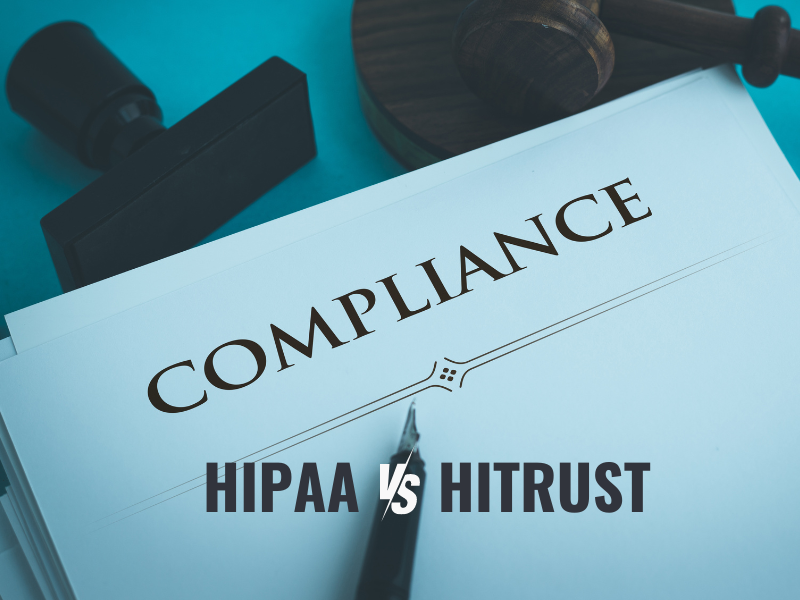HITRUST and HIPAA. Figuring out the differences between the two is critical to understanding their respective roles in regulatory compliance. While both oversee the protection of sensitive health information, one is a framework for managing risks. The other is a federal law that governs the standards for health information protection in the healthcare industry.
Let’s explore the differences between HIPAA and HITRUST in this article.
Table of Contents

HIPAA vs HITRUST: What’s the Difference?
HIPAA and HITRUST differ in their regulatory scopes. HITRUST is a third-party compliance solution that offers a global security and risk management framework. On the other hand, HIPAA is a federal law governing PHI or protected health information privacy and security.
HIPAA states the Privacy and Security requirements for the protection of PHI. Meanwhile, HITRUST outlines a flexible framework to ensure compliance with HIPAA and other regulatory bodies.
Navigating Healthcare Compliance Standards
Both HIPAA and HITRUST ensure compliance, but each differs in scope and processes.
Health Insurance Portability and Accountability Act (HIPAA)
HIPAA is a federal law that ensures the secure and proper handling of PHI between covered entities and business associates. Regulated by the U.S. Department of Health and Human Services’ Office for Civil Rights (OCR), this law oversees those who store and transmit PHI, such as medical providers, insurance companies, and third parties or healthcare software companies.
Those required to adhere to HIPAA must comply with a set of standards under the following rules:
- Privacy Rule: This rule sets limits and conditions on how a PHI may be used or disclosed with proper authorization.
- Security Rule: This rule establishes the security requirements to protect individuals’ electronic personal health information.
- Breach Notification Rule: This rule requires covered entities to notify affected patients and other individuals, the U.S. Department of Health and Human Services (HHS), and the media after a data breach.
Health Information Trust Alliance (HITRUST)
HITRUST is a non-profit organization that developed the Common Security Framework (CSF), a certifiable framework essential for regulatory compliance and risk management. Since HIPAA doesn’t provide a specific roadmap for achieving compliance, HITRUST fills this gap. HIPAA can be costly and difficult to navigate, which is where the non-profit organization comes in.
The HITRUST CSF provides prescriptive controls and requirements for organizations to achieve HIPAA compliance and transparency with other regulatory standards. It also simplifies compliance using a single, streamlined framework with more than 40 security standards and regulations, such as:
- International Information Security Standard (ISO)
- Payment Card Industry Data Security Standard (PCI-DSS)
- National Institute of Standards and Technology (NIST 800-53)
- NIST Cybersecurity Framework
- Control Objectives for Information and Related Technologies (COBIT)
- General Data Protection Regulation (GDPR)

The Key Differences Between HIPAA and HITRUST
The main difference between HIPAA and HITRUST is that the former is a United States law that sets standards for protecting patient health information. The latter is a certification program providing a framework for organizations to demonstrate compliance with HIPAA and other relevant regulations.
Below are the key differences in their regulatory scope, certification, framework, flexibility, specificity, and third-party assessments.
HIPAA vs HITRUST Framework: Regulatory Scope
HIPAA applies to everyone with personally identifiable health information. In this regard, the HIPAA regulatory scope only covers organizations conducting electronic health transactions involving the use and disclosure of PHI.
Meanwhile, the HITRUST framework is grouped into 14 control categories with 49 Control Objectives, 156 Control References, 3 Implementation Levels, and 19 Domains such as:
- Access control
- Risk management
- Incident management
- Physical and environmental security
- Business Continuity Management
- Configuration management
- Mobile device security
- Network protection
- Privacy Practices
- Vulnerability management
- Wireless security
- Asset management
- Endpoint protection
- Human resources security
- Password management
- Third-party assurance
- Transmission Protection
- Audit logging and monitoring
- Security policy
- Compliance
Each category has corresponding implementation requirements for meeting the technical objectives. HITRUST has three progressive implementation tiers: Levels 1, 2, and 3. These depend on the risk factors, available resources, regulatory landscape, and the nature of the HITRUST assessment.

Flexibility vs Specificity
HITRUST, through a comprehensive and flexible framework, helps organizations meet the risk management and compliance requirements of HIPAA and other regulatory standards. Furthermore, it follows a risk-based approach with multiple levels of implementation.
As for HIPAA, it takes on a unified approach that is only specific and limited to the healthcare industry. However, it doesn’t mean that it only covers medical professionals. It applies to all entities handling protected health information, including their business associates.
Third-Party Assessments
A HIPAA risk assessment evaluates and identifies potential threats to the privacy and security of PHI. This includes the possibility of a data breach and its impact to the affected individuals and organization. It will also determine whether there are adequate security measures and policies to prevent or overcome privacy and security breaches.
Meanwhile, the HITRUST Third-Party Risk Management (TPRM) Methodology provides a standard gap analysis approach for organizations in any industry to evaluate the risks. The only difference is that HITRUST allows organizations to complete self-assessments where they’ll receive recommended administrative, technical, and physical controls for compliance. Afterward, a HITRUST assessor will perform an audit.
Choosing Between HIPAA and HITRUST
HITRUST vs HIPAA? Although HIPAA lays out the basic guidelines for safeguarding patient health information, HITRUST provides a more comprehensive and strict data security and privacy approach. Organizations handling sensitive healthcare data may find that implementing HITRUST offers greater assurance, as it includes additional controls and requirements beyond what HIPAA requires.
Ultimately, the decision should depend on your organization’s regulatory obligations, level of risk tolerance, and security needs.







